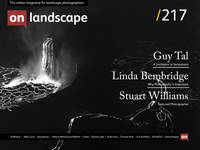
Huibo Hou
Huibo’s image of the Witch’s Finger (Trølkonufingur) in the Faroe Islands is a great example of emotive feeling exploding out of an image. To say it’s got drama is to do it a disservice. The view here is epic, monumental, awesome in the Burkian sense of the sublime. more

Portrait of a Photographer – Cecil Whitt
Cecil and his work exemplify the mysteries of the desert Southwest and conjure up a wide variety of emotions and ideas including solitude, surprise, serenity, rugged individualism, grit, determination, exploration, and optimism. more

The Sublimity of Toxic Beauty
As I then read up about the Terminal Mirage 2, 2003, I discovered that I was looking at an aerial photograph of Utah’s Great Salt Lake. more

Learning from Others
Being in "lockdown" (or quarantine, whatever you decide to call it), has created lots of time to reflect on the photographic practice of other photographers who inspire me. more

Portrait of a Photographer – Anna Morgan
I get the sense that the subject is much deeper than a collection of simple objects in nature, rather, each image asks the viewer to reflect deeper within oneself to find something more. more

Perfection in Nothingness
What does this image convey to you? A feeling of peace, calm and quietness? Does it suggest tranquillity and harmony? Perhaps a meditative feeling, of a sense of emptiness? more

Portrait of a Photographer- Jimmy Gekas
He approaches every trip and scene with the same lack of expectation and embodies what the Buddhists call “Shoshin,” which roughly translates as “beginner’s mind.” more

It’s Up To You What You See
Abstract art can be the most frustrating of art forms, but it can also be the most rewarding. There is a simple reason for this I think: the responsibility for finding ‘meaning’ in an image is thrown entirely on to the viewer. more

The Timeless Horizon
The monochrome toning of the water seems to increase that sense of constant, ageless solidity. It has a luminosity that feels metallic, not in a polished and reflective sense, but matt and translucent. more

Compare and Contrast
I guess this analytical approach stuck because as I look at these two photographs by Finn Hopson, I can’t help but react in exactly the same way. They both have the same subject – woodland scenes with mist and fog. They are structured very similarly – strong verticals bisected by flowing horizontals. But their mood is completely different. more

Landscape and the Picturesque
It’s interesting to analyse the mood that pictures create, the feelings they inspire, and to link that back to the decisions the photographer must have made at the moment of making the image. more

Geometrical Landscapes
The viewpoint has turned this into an image that is actually about something completely different. What we see here is a perfectly balanced geometric patterned rendition of the landscape. more

Steve Gosling and the desire to touch…
Two images then, one which calls for the viewer to reach out and stroke its softness whilst the other forbids any such interference. more

Thomas Peck’s Critiques
The results of long exposures to the passage of the sun are quite extraordinary. The images all have a deep gash where the sun has burned a hole in the paper. more

Thomas Peck’s Critiques
I make no apologies for focussing on Marc Adamus in this article. A photographer who, in every sense of the word (awe, majesty, grandeur, fear etc), makes Sublime images. more

